One reason why playing acoustic guitar is so popular is because it’s so easy to get started. All you really need is the guitar itself, pick it up from time to time, and learn something new. However, things get a bit more complicated when you decide to share your playing with the world, whether through a studio recording or a live performance.
You see, even though there are plenty of acoustic guitars out there with internal electronics, plugging it in and playing live/recording direct might not be the best decision. Why? Because the built-in pickup inside your acoustic guitar captures the sound from inside the body of the instrument, which can sound fairly thin and bland when compared to the rich, booming tone resonating from the soundhole of the guitar.
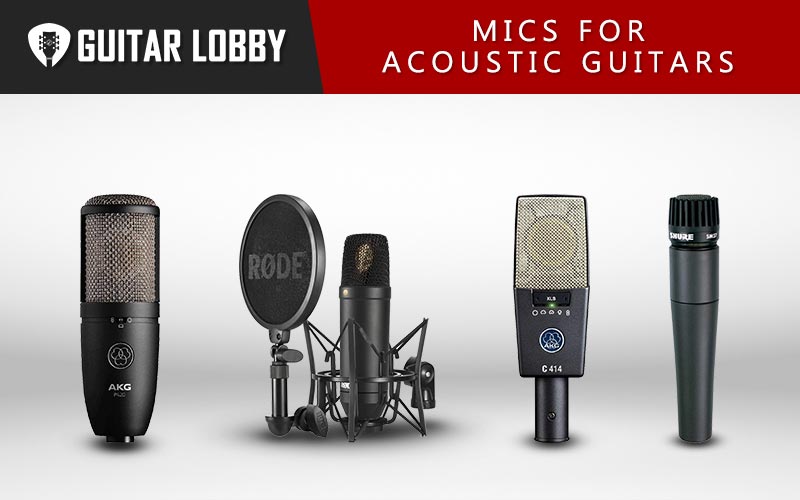
So, if you are after sound quality alone, getting a microphone would be the right way to go, but then you find that there is such a thing as too many choices, especially if you don’t know much about mics. There is no one-size-fits-all solution because the best microphone for your acoustic guitar might simply be one that works best in a given setting.
I’ll start this article by jumping right into reviews on the best mic for acoustic guitars at each price point, but if you want to learn more before reading reviews, check out our microphones guide at the bottom of the page here for detailed info on everything you’ll need to know before choosing a microphone.
| Name of Product | Image of Product | Description | Price Range | Full Review |
|---|---|---|---|---|
| 1. Shure SM81-LC (Best Overall) | 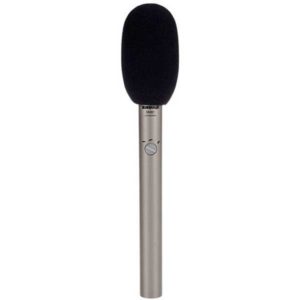 | Type: Condenser Diaphragm Size: Small | $350 | Read Full Review Below |
| 2. Rode NT1KIT Cardioid Condenser Microphone (Best Value) | 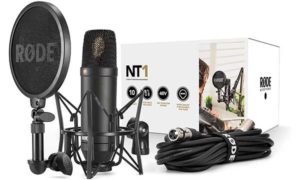 | Type: Condenser Diaphragm Size: Large | $270 | Read Full Review Below |
| 3. AKG Pro Audio P420 (Best Under $200) | 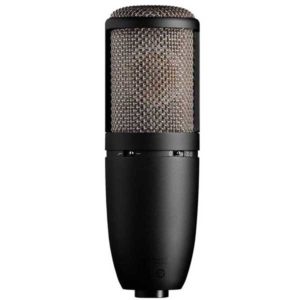 | Type: Condenser Diaphragm Size: Large | $200 | Read Full Review Below |
| 4. Shure SM-57 Cardioid Dynamic Microphone (Best Under $100) | 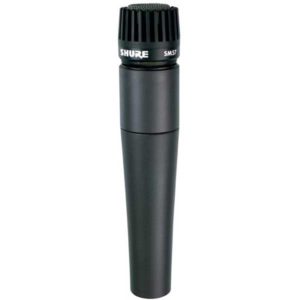 | Type: Dynamic Diaphragm Size: Small | $100 | Read Full Review Below |
| 5. Shure BETA 58A Supercardioid Dynamic Vocal Microphone | 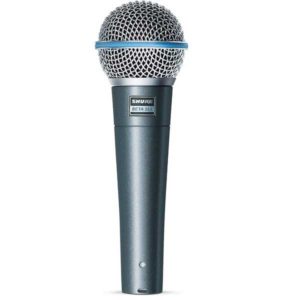 | Type: Dynamic Diaphragm Size: Small | $160 | Read Full Review Below |
| 6. Audio-Technica AT2020 Cardioid Condenser Microphone | 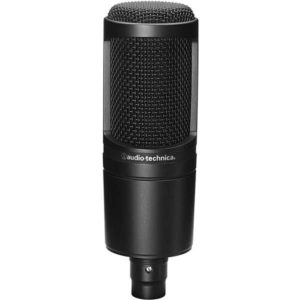 | Type: Condenser Diaphragm Size: Large | $100 | Read Full Review Below |
| 7. MXL Mics 770 Cardioid Condenser Microphone | 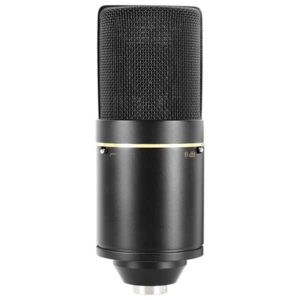 | Type: Condenser Diaphragm Size: Small | $120 | Read Full Review Below |
| 8. AKG Pro Audio C414 XLS Condenser Microphone | 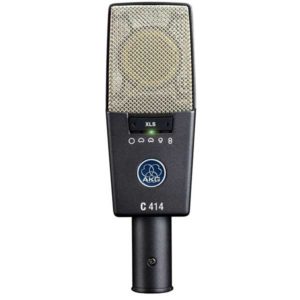 | Type: Condenser Diaphragm Size: Large | $1075 | Read Full Review Below |
| 9. Rode NT5 Compact Cardioid Condenser Microphone | 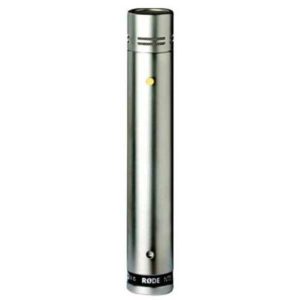 | Type: Condenser Diaphragm Size: Small | $220 | Read Full Review Below |
| 10. AKG Perception 170 Microphone | 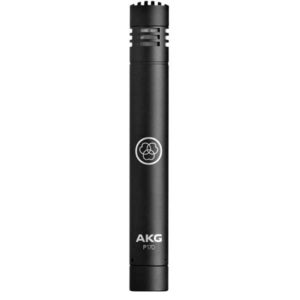 | Type: Condenser Diaphragm Size: Small | $100 | Read Full Review Below |
| 11. Sennheiser E609 Silver Super Cardioid Microphone | 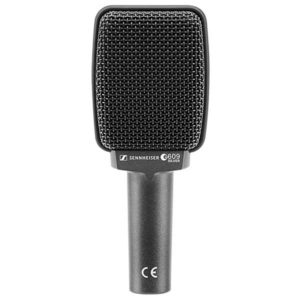 | Type: Condenser Diaphragm Size: Large | $100 | Read Full Review Below |
| 12. MXL 990 XLR Connector Condenser Microphone | 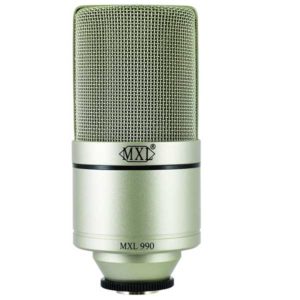 | Type: Condenser Diaphragm Size: Large | $75 | Read Full Review Below |
| 13. Aston Microphones Cardioid Condenser Microphone | 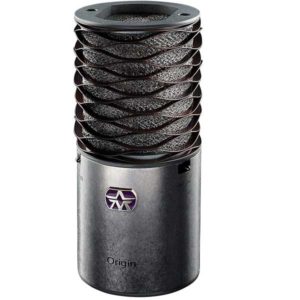 | Type: Condenser Diaphragm Size: Large | $300 | Read Full Review Below |
| 14. Neumann U 87 Ai Switchable Studio Microphone | 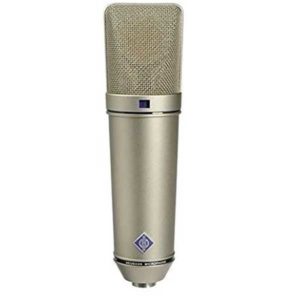 | Type: Condenser Diaphragm Size: Large | $3200 | Read Full Review Below |
| 15. Audio-Technica AT4040 Cardioid Condenser Microphone | 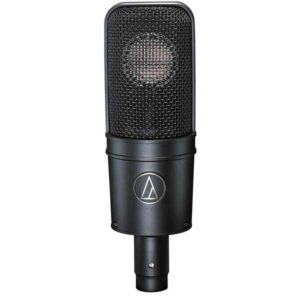 | Type: Condenser Diaphragm Size: Large | $300 | Read Full Review Below |
| 16. Rode M5-MP Matched Pair Cardioid Condenser Microphones | 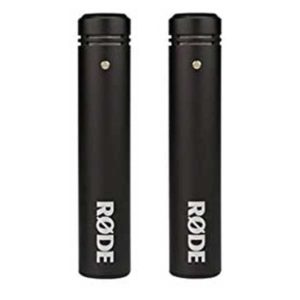 | Type: Condenser Diaphragm Size: Small | $195 | Read Full Review Below |
| 17. AKG Pro Audio C1000S Diaphragm Condenser Microphone | 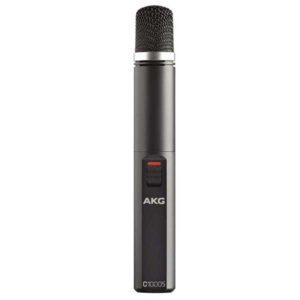 | Type: Condenser Diaphragm Size: Small | $170 | Read Full Review Below |
Here Are the Best Microphones for Acoustic Guitars
1. Shure SM81-LC (Best Overall)
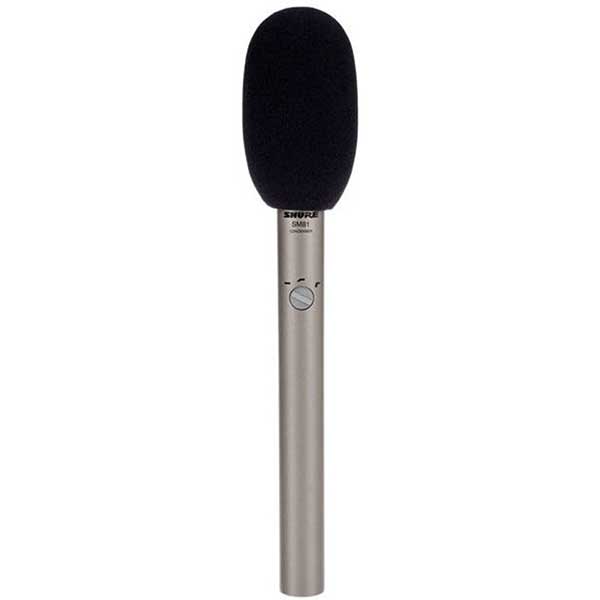
| Estimated Price | $350 |
| Type | Condenser |
| Diaphragm Size | Small |
| Polar Pattern | Cardioid |
| Frequency Response | 20Hz-20kHz |
| Max SPL | 136dB |
| Impedance | 150 Ohms |
My Review: You would be hard-pressed to find a professional recording studio that doesn’t have at least one Shure SM81 around. Shure has its share of legendary products, and this one has pretty much become an industry standard for recording acoustic guitar. Although not the cheapest mic on this list by any means, it is still a great value when you consider that it can capture the crystal-clear sound of your acoustic guitar just as well as high-end Neumann mics, at a fraction of the price. If you can afford a pair of these, you will be able to make professional-sound recordings that are neck and neck to those captured by mic sets that are much more expensive.
Because it’s a small diaphragm condenser cardioid microphone, it ticks all the right boxes when it comes to clarity, noise rejection, and capturing all those sweet treble tones acoustic guitars are known for. And it’s not just perfect for acoustics either, because its maximum SPL allows it to handle even the loudest sources, such as guitar amps and drums. Its small “pencil-style” shape enables you to position it with ease in any kind of studio setting. It requires phantom power, like all condenser mics, preferably a 48 Vdc power supply.
Who Will Use This Most: Studio professionals looking to get the most out of acoustic guitar sounds, but given the SM81’s price point, it will also be accessible to advanced amateurs and those with deeper pockets. Live performers, however, might be better suited with a robust dynamic mic alternative.
Bottom Line: The Shure SM81 is essential if you are looking to record acoustic guitar without any sort of compromise when it comes to sound quality. Despite the famous Shure build quality and specs, the SM81 provides great value for money, and if you can afford it, you should buy it without thinking twice about it. Many professionals consider this the best mic for recording acoustic guitar.
2. Rode NT1KIT Cardioid Condenser Microphone (Best Value)
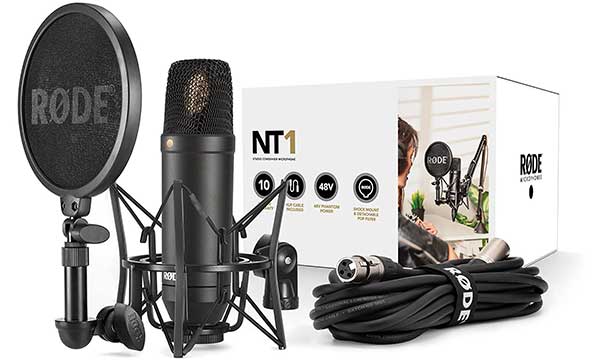
| Estimated Price | $270 |
| Type | Condenser |
| Diaphragm Size | Large |
| Polar Pattern | Cardioid |
| Frequency Response | 20Hz-20kHz |
| Max SPL | 132dB |
| Impedance | 100 Ohms |
My Review: If you are looking to get the most bang for your buck, then you should look no further than the Rode NT1KIT microphone package. Rode is a reputable brand, so it’s really nice to see such a quality package at such a price range. In fact, the microphone alone can tackle rivals twice its price in terms of sound quality. And because it comes with a kit, you also get everything you need to start recording your guitar, and that includes a shock mount, cover, and a pop filter. You won’t even have to go out and buy a cable, because it comes with an XLR cable as standard.
And since Rode NT1 is a large-diaphragm condenser microphone with a cardioid polar pattern, it will easily capture all the nuances of an acoustic guitar, from loud strumming to the sound of the pick hitting the strings. Mind you, large-diaphragm mics capture more noise as well, but thanks to all the bells and whistles that come as standard, you will be able to reject most of it. And it’s a stunningly quiet mic, as well, with a self-noise level of only 4.5 dBA.
Who Will Use This Most: The Rode NT1 is ideal for singer-songwriters because it records both the vocals and the acoustic guitar equally well. This is arguably the best combo you can find for your home studio setup, but it won’t feel out of place in most recording studios, or even in a live setting.
Bottom Line: The Rode NT1KIT provides great value for money, without forcing you to sacrifice recording quality in order to compensate for the price tag. High dynamic range, low self-noise, and all the accessories that come with it make it the best value option on our list of mics for acoustic guitar. Overall, this is easily one of the best microphones for acoustic guitar recording.
3. AKG Pro Audio P420 (Best Under $200)
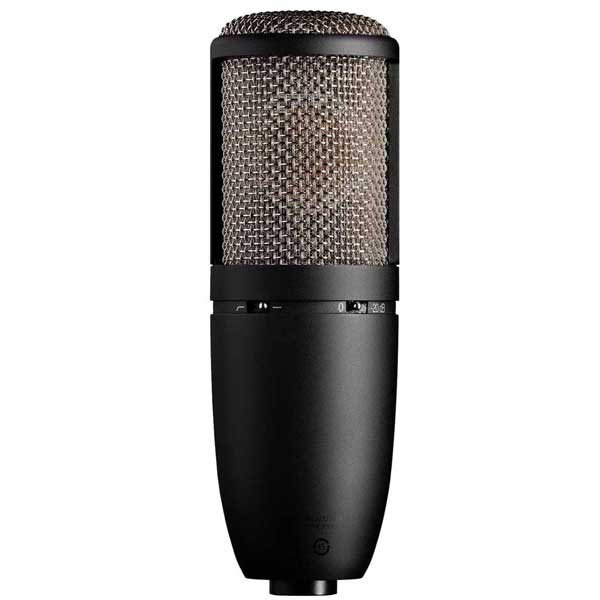
| Estimated Price | $200 |
| Type | Condenser |
| Diaphragm Size | Large |
| Polar Pattern | Multipattern |
| Frequency Response | 20Hz-20kHz |
| Max SPL | 155dB |
| Impedance | 200 Ohms |
My Review: The AKG P420 is an incredibly versatile condenser microphone because it comes equipped with a dual diaphragm that allows you to choose the mic’s polar pattern. This large-diaphragm microphone allows you to choose between three patterns when recording your acoustic guitar: cardioid, omnidirectional, and Figure-8. It comes with a shock mount, metal carrying case, -20 dB pad switch, and a bass-cut filter switch for better noise removal. AKG is a great brand for mics, and this offering is no exception.
Because you can switch between different patterns, you will be able to record a whole bunch of different sounds, not just your acoustic guitar. For just under $200, it’s almost impossible to find an acoustic guitar mic that provides you with such a range of applications as this one does. As for the sound itself, the AKG P420 works really well with acoustic guitars, and the resulting sound is always crisp and flattering, even when it comes to higher frequencies. This is affordability and versatility all rolled into one. And it’s heavy and sturdy, as well.
Who Will Use This Most: Due to its jack-of-all of trades versatility and a decent price tag, it’s hard to imagine anyone not wanting to use the AKG P420 for any kind application. It’s brilliant for home recordings, but it’s no less effective as an in-studio workhorse of a microphone.
Bottom Line: At just under $200, the P420 is a steal in terms of sound quality, as well as the wide range of applications and settings you can use it in. It’s pretty much impossible to find a mic with these specs at a similar price. You won’t ever regret buying it.
Popular Related Articles: American Made Guitars You Need to Know About
4. Shure SM-57 (Best Under $100)
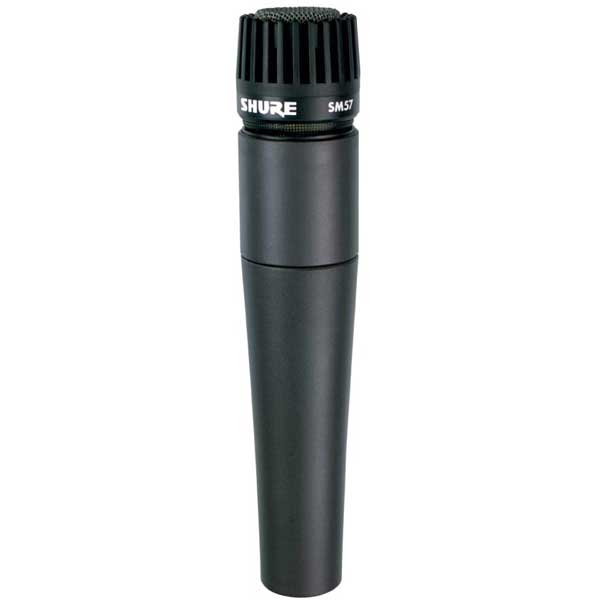
| Estimated Price | $100 |
| Type | Dynamic |
| Diaphragm Size | Small |
| Polar Pattern | Cardioid |
| Frequency Response | 40Hz-15kHz |
| Max SPL | 94dB |
| Impedance | 150 Ohms |
My Review: Although you might think a microphone that costs under $100 isn’t any good, you would be wrong, at least in the case of the Shure SM-57 microphone. The SM-57 is a permanent staple in most professional recording studios, as well as most live stages around the world. In fact, if we could pick one mic that is absolutely essential for recording and micing an acoustic guitar, it would be this, simply because of its iconic and well-deserved status. The SM-57 is a dynamic mic, making it the perfect choice if you want to mic your guitar in a live setting, and because of its tough build and shock-mount system, it can withstand pretty much anything you can throw at it.
Believe it or not, it has been around since the ’60s, and the only thing that has been changed is the voice coil, which is now aluminum instead of copper. It works great with acoustic guitars, harmonicas, bass cabs, guitar amps, drums, you name it. Because of the cardioid pattern, it can capture guitar sound with great precision, and reject most of the noise from its surroundings, which comes in handy both on stage and inside the studio.
Who Will Use This Most: Everyone, and we do mean everyone. Seasoned professionals use it, and those who are just getting into recording and micing their acoustic guitars will see it as a logical choice due to SM-57’s affordability. But the price tag is just the tip of the iceberg because this mic delivers professional-level sound without any tradeoffs.
Bottom Line: Nearly indestructible build, low price, crystal sound, versatility, and zero distortion are all of the things you would want in a mic, and the Shure SM-57 ticks all of those boxes and then some. And we guarantee there is zero chance of you not liking the sound because all of your favorite acoustic guitar tunes were probably recorded using this mic. If you have a $100 budget, in my opinion, this is the best mic for acoustic guitars under $100 out there.
5. Shure BETA 58A Dynamic Vocal Microphone
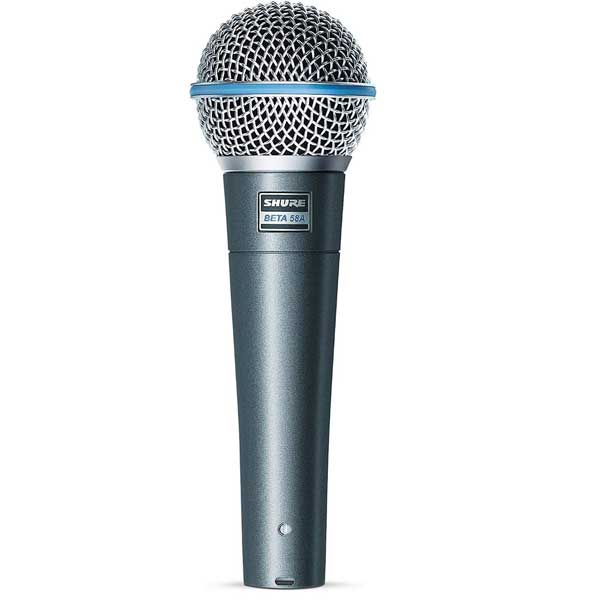
| Estimated Price | $160 |
| Type | Dynamic |
| Diaphragm Size | Small |
| Polar Pattern | Supercardioid |
| Frequency Response | 50Hz-16kHz |
| Max SPL | 140.5dB |
| Impedance | 150 Ohms |
My Review: The Shure BETA 58A is as reliable as they come, and it’s definitely one of the all-time great mics Shure has ever made. On the exterior, it’s a tough workhorse, with a handle made out of diecast metal, and a stainless steel mesh grille, able to take a beating on any stage. If you are looking for a microphone that has a strong output for studio or live performance, this is the one you need to be looking at. On the inside, it has a neodymium magnet which enables it to have a really impressive signal-to-noise ratio, which results in a really clean and noise-free sound.
Because this is a dynamic supercardioid mic, you will often see vocalists use it live, because it captures all those big sounds easily, along with just enough ambient noise to make everything sound natural. When it comes to using it to mic acoustic guitars, it might not be the best choice for live performances, because of its supercardioid polar pattern, which picks up more sound coming from the back of the mic. This pattern is also less sensitive at the front, which means you have to stay put while playing, and that is not always easy when playing live. In the studio, however, those very traits enable it to capture the entire range of acoustic guitar sounds, along with the sound of the room, which makes for a nice, full sound.
Who Will Use This Most: Guitar players which are looking for a high-output mic that allows them to record a big, full sound of their acoustic guitar at home or in the studio. Despite it being a dynamic mic, live performers will have a tough time making the most of it due to the supercardioid pattern and lack of on-off switch.
Bottom Line: The Shure BETA 58A is a fantastic mic if you are looking to record your acoustic guitar. In terms of live performance, it’s more suitable for concert halls where the guitar player is more stationary. It’s really hard to ignore the rich sound captured by this microphone.
Related Article: Recommended Guitar Cables (All Price Ranges)
6. Audio-Technica AT2020 Cardioid Condenser Mic
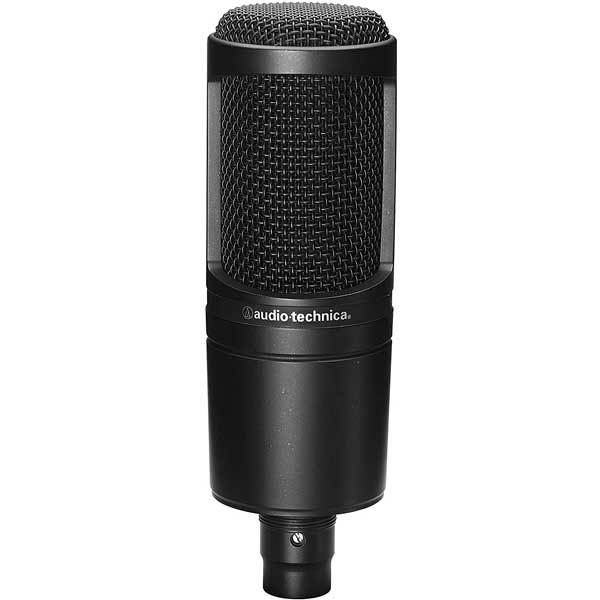
| Estimated Price | $100 |
| Type | Condenser |
| Diaphragm Size | Large |
| Polar Pattern | Cardioid |
| Frequency Response | 20Hz-20kHz |
| Max SPL | 144dB |
| Impedance | 100 Ohms |
My Review: Yet another mic on this list that proves you can get a great-sounding microphone for around just under $100. The AT2020 is very popular among vocalists and podcasters, but where it really shines is the recording of acoustic instruments, especially guitars. You get a high-quality large-diaphragm condenser mic for a low price which is ideal for any kind of home studio setup, and it might even work in some professional studio as an addition to the more high-end large-diaphragm condenser mics.
It has a really wide dynamic range, which means it will capture both the low and the high end of the guitar, and thanks to the high SPL, you won’t have to worry about strumming hard, because there is no distortion. The cardioid polar pattern, on the other hand, makes sure that all of those subtle tones and picking during solos will be recorded as well. Compared to other large-diaphragm condenser mics at the same price, the AT2020 is pretty much superior to all of them, which is why it’s the #1 bestseller on Amazon in the category of vocal condenser mics.
Who Will Use This Most: Singer-songwriters, as this mic is ideal for both vocals and acoustic guitars, those with a home studio setup, as well as those looking to get a good recording mic on a tighter budget. Suitable for some professional studio applications as well.
Bottom Line: Even though it’s very affordable, the Audio Technica AT2020 XLR mic is brilliant at capturing the entire range of an acoustic guitar, thanks to its high SPL and large diaphragm. At just under $100, it’s a bargain, and if you are in the market for a large-diaphragm mic, this one definitely earns our recommendation.
7. MXL-770 Cardioid Condenser Microphone
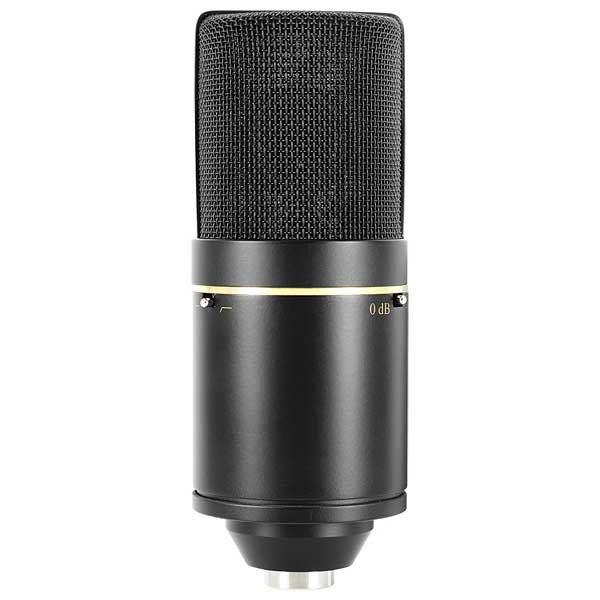
| Estimated Price | $120 |
| Type | Condenser |
| Diaphragm Size | Small |
| Polar Pattern | Cardioid |
| Frequency Response | 30Hz-20kHz |
| Max SPL | 137dB |
| Impedance | 150 Ohms |
My Review: MXL is among those brands which always offer a terrific price/quality ratio, and the MXL Mics 770 cardioid condenser mic is no exception. Those looking for an affordable acoustic guitar mic that is able to capture clear, distortion-free sound will find much to like here. It comes in a sturdy, foam-padded plastic case, and you also get a really cool-looking vintage-style shock mount to go along with it. The MXL 770 looks and feels like a more expensive mic. Even though its design might indicate otherwise, it’s a small diaphragm microphone that is really sensitive, and the cardioid pattern does a really good job capturing the noise of the acoustic guitar coming from the front and rejects most other noises.
Its self-noise level is pretty good, and it really shines when it comes to capturing the high-end of your acoustic guitar, with all notes being clear and crisp. This mic is primarily designed to record acoustic guitar, rather than mic them on stage. And this isn’t just great for recording your guitar at home either, because it works really well in just about any kind of recording situation. It works well even in a studio, thanks to its FET preamp.
Who Will Use This Most: Anyone who needs to record great-sounding guitars, be it a singer-songwriter in their home studio, or a professional studio engineer. Despite its fancy design, it’s pretty user friendly, and because it’s affordable, it’s even suitable for beginners which are looking to record their first acoustic tunes.
Bottom Line: The MXL Mics 770 is yet another proof that you don’t have to spend a fortune in order to get a good mic to record your guitar, nor do you need to sacrifice sound quality just because you can only purchase an affordable mic. It works really well in most settings, and the sound it captures rivals that of more expensive mics.
Popular Related Article: Our Favorite High End Acoustic Guitars
8. AKG Pro Audio C414 XLS Condenser Microphone
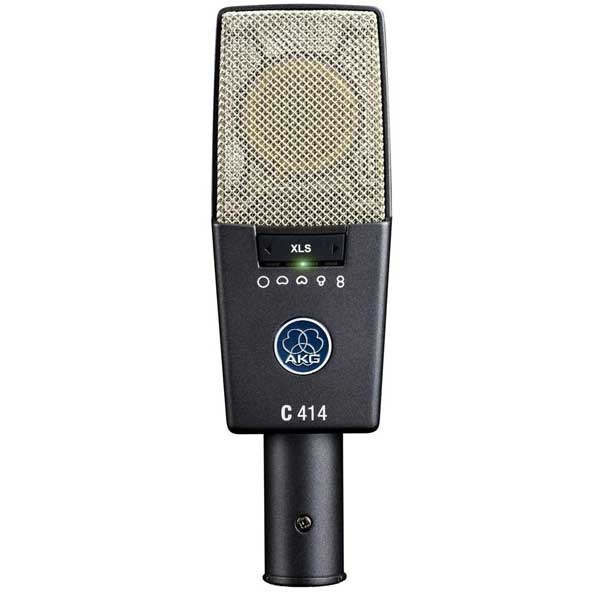
| Estimated Price | $1075 |
| Type | Condenser |
| Diaphragm Size | Large |
| Polar Pattern | Multipattern |
| Frequency Response | 20Hz-20kHz |
| Max SPL | 140dB |
| Impedance | 200 Ohms |
My Review: There are quite a few microphones on this list that can be described as iconic or legendary, and the AKG C414 definitely fits that description. It’s one of the most popular large-diaphragm mics in studios around the world and is loved by even the pickiest of professionals. Hence the price tag, which is just over $1000, but if you are looking for uncompromising quality and you don’t want to spare any expense to get it, the C414 is for you. Despite it being expensive, it’s worth every penny and then some.
Apart from the build quality that you get with AKG, this microphone is just about the most versatile piece of recording gear out there and is often likened to a Swiss Army knife because of it. And the reason why it’s so versatile is that it’s a multipattern microphone. You can choose among nine different polar patterns on the C414, which enables you to come up with the right recording setup for your acoustic guitar regardless of the guitar itself or the room in which you are recording. With it, you also get a quality carrying case, windscreen, pop filter, as well as a shock mount.
Who Will Use This Most: Obviously, due to its price tag, it will attract professionals for the most part, as well as those which put sound quality above everything else, regardless of how much they have to pay for it.
Bottom Line: By all parameters, this is one of the best mics on our list, as well as on the market. If you can’t record a brilliant acoustic guitar sound using the C414, then you might as well give up. It’s expensive, yes, but it’s basically flawless. If the price isn’t a huge factor for you, this is easily one of the best acoustic guitar mics out there!
9. Rode NT5 Compact Cardioid Condenser Microphone
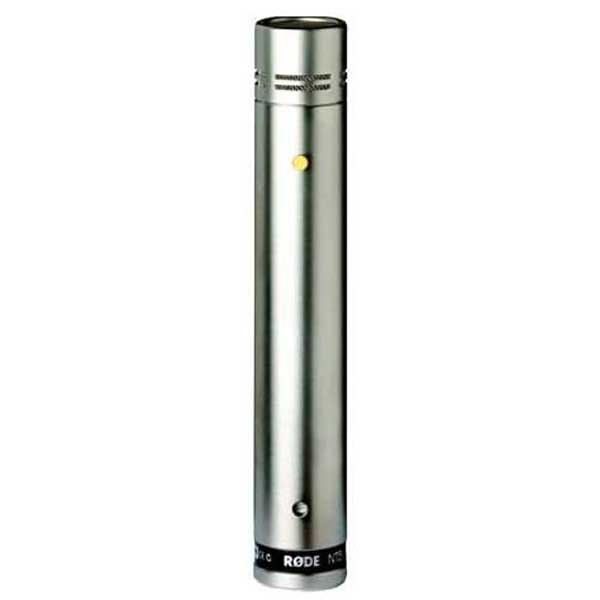
| Estimated Price | $220 |
| Type | Condenser |
| Diaphragm Size | Small |
| Polar Pattern | Cardioid |
| Frequency Response | 20Hz-20kHz |
| Max SPL | 143dB |
| Impedance | 100 Ohms |
My Review: No list of acoustic guitar mics would be complete without the Rode NT5, which is the company’s premier small-diaphragm condenser microphone. In a lot of ways, it is similar to the Shure SM81, but it’s much more affordable. In fact, if you add a bit more money, you can buy a pair of these and record your acoustic guitar in stereo. But, even as a single mic, the NT5 is outstanding, which is why it can be found all over the web and inside professional studios. Because it’s a cardioid condenser mic, it is able to capture even the finest sounds coming from an acoustic guitar, and if you happen to play other instruments such as drums or a flute, it will work equally well with them, as well.
Adding to the list pros is the low self-noise level, low impedance, and a very high SPL. All of that makes for a pretty full and detailed sound, on both ends of the range. We also love the build quality and the nickel-plated heavy-duty body, which makes the NT5 suitable for live events taking place in a more intimate setting.
Who Will Use This Most: Because it works so well with all kinds of acoustic instruments, and especially acoustic guitars, the Rode NT5 will appeal to a wide variety of musicians looking for a quality stereo recording. But, the price is still decent enough so that you can afford one for your home studio setup too.
Bottom Line: The Rode NT5 is a great pencil-style condenser microphone that works really well inside any studio, especially for acoustic instruments. But, it’s also sturdy and capable enough for you to use in a live setting.
Related Article: Quality Mics for Guitars Amps and Recording Electric Guitars
10. AKG Perception 170 Professional Microphone
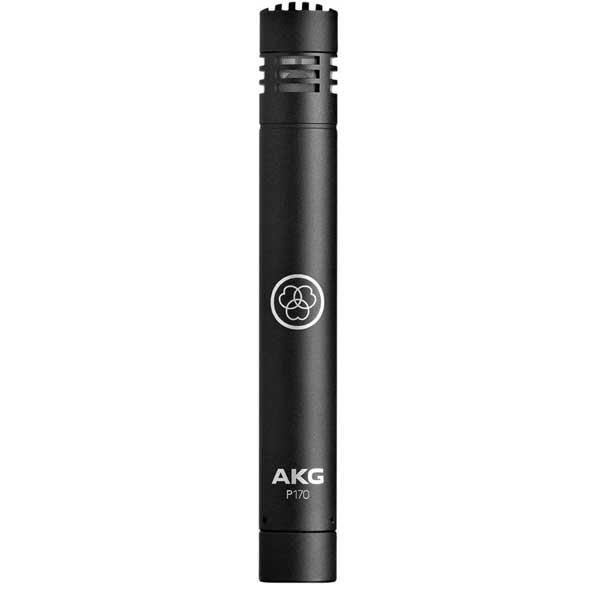
| Estimated Price | $100 |
| Type | Condenser |
| Diaphragm Size | Small |
| Polar Pattern | Cardioid |
| Frequency Response | 20Hz-20kHz |
| Max SPL | 155dB |
| Impedance | 200 Ohms |
My Review: We have already dispelled the notion that cheap microphones are always crappy, and the AKG Perception 170 solidifies our claim even further. But, there is a reason why this microphone is one of the most popular instrumental mics out there. The Perception 170 can handle really high sound pressure levels, which makes it a favorite among guitar players and studio connoisseurs alike. In fact, a pair of these is often a solution of choice for those looking to record their acoustic guitar in stereo, without breaking the bank.
Plus, it can represent a nice addition to an already existing setup with a large-diaphragm microphone, like some that are featured on our list. It’s not very versatile and it’s not great for vocals, but it’s brilliant when it comes to capturing the sound of acoustic guitars, drums, and percussions, thanks to its high SPL, with very little or no distortion. The AKG Perception 170 was clearly designed with one purpose in mind, and it fulfills that purpose brilliantly.
Who Will Use This Most: Acoustic guitars players looking to record great audio on the cheap, as well as seasoned studio professionals looking to expand their studio setup with a small-diaphragm condenser mic for additional micing.
Bottom Line: The AKG Perception 170 is not a very versatile mic, but it is affordable, sturdy, and great at doing what it intended to do: record acoustic guitar. If you can afford it, we also recommend getting a pair of these for stereo recording.
11. Sennheiser E609 Silver Super Cardioid Microphone
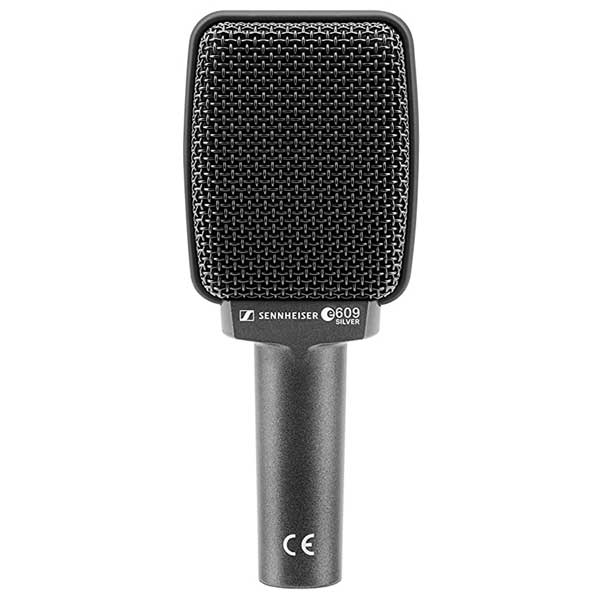
| Estimated Price | $110 |
| Type | Condenser |
| Diaphragm Size | Large |
| Polar Pattern | Cardioid |
| Frequency Response | 30Hz-20kHz |
| Max SPL | 130dB |
| Impedance | 200 Ohms |
My Review: One of the most popular dynamic microphones for recording acoustic guitar is the Sennheiser E609. Right off the bat, you will notice its stylish design featuring a flat face, which allows you to position it right in front of your guitar. Thanks to its high SPL, it can easily handle loud sounds, and it feels right at home even if you hang it in front of an amp. Because it features a supercardioid polar pattern, it can isolate your acoustic guitar from other instruments, as well as noise, regardless of the surroundings. It’s pretty rugged too, which means you can also use it live. Its handle is made of metal, while the mesh grille is made out of steel, with plastic edges.
The E609 also has a hum-compensating coil and a Neodymium magnet which also contributes to the crispness of the sound and low noise. Its frequency response is also very impressive, as it ranges between 40Hz and 18KHz. When you put all that together, this mic is able to reject feedback with ease, and the resulting sound is very accurate.
Who Will Use This Most: Because of its rugged construction, flat-face design, this dynamic mic is suitable for both stage and studio, especially if you want your acoustic guitar to sound great despite the noisy environment. It’s affordable enough so that even a beginner can get one, as well.
Bottom Line: The Sennheiser E609 dynamic microphone is perfect if you want your acoustic guitar to stand out in a live setting, as well as for recording sound which is very clean, accurate, and unflavored. It can pretty much handle as much noise as you can throw at it and it will still sound great.
12. MXL 990 XLR Connector Condenser Microphone
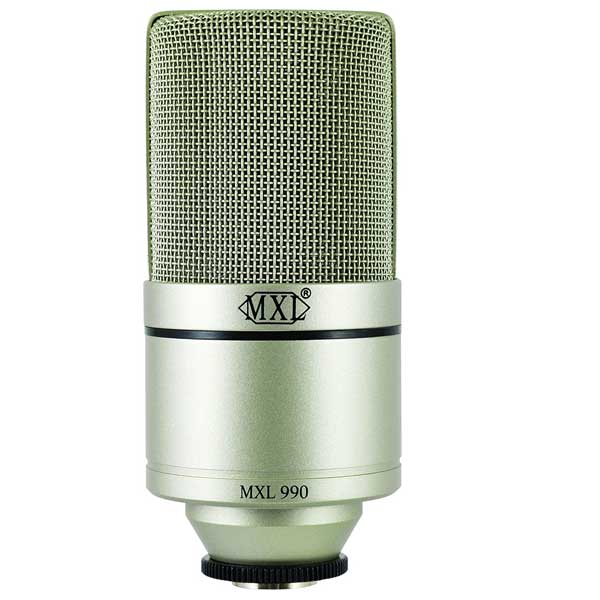
| Estimated Price | $75 |
| Type | Condenser |
| Diaphragm Size | Large |
| Polar Pattern | Cardioid |
| Frequency Response | 30 Hz – 20 kHz |
| Max SPL | 130 Db |
| Impedance | 200 Ohms |
My Review: We know we have featured a fair bit of cheap mics here, but all of those were priced at just under $100. Surely going lower than that can’t get you much in terms of sound, right? Well, it turns out it can, provided that you get the MXL 990 large-diaphragm condenser microphone. It doesn’t offer a lot in terms of bells and whistles, which is normal for the price, but you do get a shock mount, mic stand adapter, and a carrying case. Like all good MXLs, this one also comes with their FET preamp which makes the mic perform very consistently.
In terms of sound, the MXL 990 has a warm midrange sound, and the tone itself is very accurate and rich, without much muffling or coloring. Due to somewhat lower SPL, it’s not ideal for louder instruments or amps, but it does handle acoustic guitars extremely well. When it comes to noise, it can filter out most of the ambient noise thanks to its cardioid pattern, and the level of self-noise is pretty good, as well. It would be more than welcome in most studios.
Who Will Use This Most: Even though the MXL 990 is an entry-level mic, its sound is a lot bigger and more well-defined. That is why this mic is ideal for both players who want to try recording their acoustic guitar for the first time, as well as for studio use, especially when accompanied by a good pop filter.
Bottom Line: Although not as fancy or feature-rich as some of the mics on this list, the MXL 990 is still a very good microphone, and your acoustic guitar will sound like it was recorded on a much more expensive microphone.
13. Aston Microphones Origin Cardioid Condenser Microphone
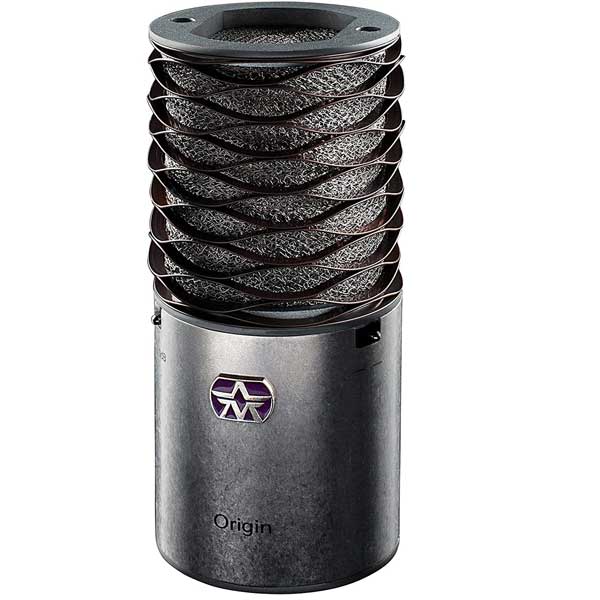
| Estimated Price | $300 |
| Type | Condenser |
| Diaphragm Size | Large |
| Polar Pattern | Cardioid |
| Frequency Response | 20Hz-20kHz |
| Max SPL | 127dB |
| Impedance | Not Available |
My Review: Aston is a relatively new company since it was founded back in 2015, but it has already made quite a reputation for itself, winning numerous awards and earning both industry and customer praise, while offering only a handful of microphones. We have selected the Aston Microphones Origin cardioid condenser microphone for our list, and based on what we have been able to conclude, all the hype surrounding the brand has been justified. It costs around $300 dollars, which puts it somewhere in the middle of the range, but when it comes to sound, it has often been compared to the iconic Neumann U 87, which says a lot about it.
Acoustic guitars recorded using this mic sound very clean, with every little detail captured. There is a very unusual quality to the sound you get with this mic, which can be best described as lush or spacious. Given that it’s a large-diaphragm microphone, this is somewhat expected, but we were still surprised by the sheer quality of sound. It also features some clever design solutions, such as the built-in pop filter, which means you won’t ever waste time looking for one. Plus, it mounts directly onto the stand, so you don’t need a shock mount or a cradle.
Who Will Use This Most: Because of the superior sound quality, it can be used in any kind of studio environment, and it’s even suitable for capturing takes which will end up on actual albums. It’s that good. And because of the moderate price, hobbyists will be able to afford one as well.
Bottom Line: The sound coming from the Aston Microphones Origin mic pretty much blew us away, as we didn’t expect it to sound that good, or to feature any of the interesting design improvements which cannot be found on other mics. Highly recommended.
14. Neumann U 87 Ai Switchable Studio Microphone
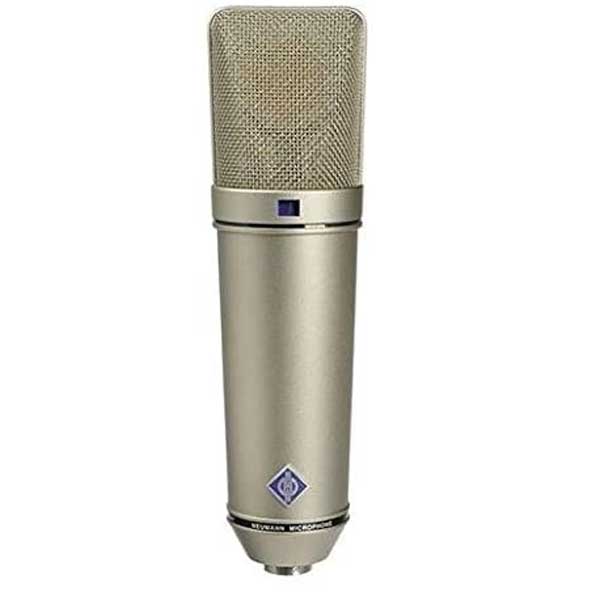
| Estimated Price | $3200 |
| Type | Condenser |
| Diaphragm Size | Large |
| Polar Pattern | Multipattern |
| Frequency Response | 20Hz-20kHz |
| Max SPL | 117dB |
| Impedance | 200 Ohms |
My Review: If you are looking for the absolute best when it comes to recording acoustic guitar, vocals, strings, piano, or any kind of sound inside the studio, the Neumann U 87 Ai represents the gold standard. It is the direct successor of the legendary U 87 introduced back in 1967, which is arguably the greatest recording mic of all time. If you were to walk into any world-class studio, you would find one of those there. The U 87 Ai picks up right where the U 87 left off, offering a selectable polar pattern and unparalleled quality and reliability.
You can choose among cardioid, omnidirectional, and Figure-8 patterns, and you also get to make use of a high-pass filter. There is absolutely no situation where the Neumann U 87 Ai is anything less than sublime, which it should be, considering the huge price, but that’s pretty much what you need to pay for absolute perfection. It is hands-down the best large-diaphragm microphone ever. It comes in a wooden jeweler’s box, and you also get a windscreen, cable, and elastic suspension.
Who Will Use This Most: Obviously, this is aimed at professional musicians, as well as studio engineers, producers, and owners who are looking to cater to those musicians. The kind of money you need to pay for it puts it out of reach for any other purpose than the high-end studio recording.
Bottom Line: The Neumann U 87 Ai is the performance and quality benchmark when it comes to the studio recording of any kind. It’s wildly expensive, but in terms of sound, you cannot do any better than this. Highly recommended, provided that you are one of the few lucky ones able to afford it.
15. Audio-Technica AT4040 Cardioid Condenser Microphone
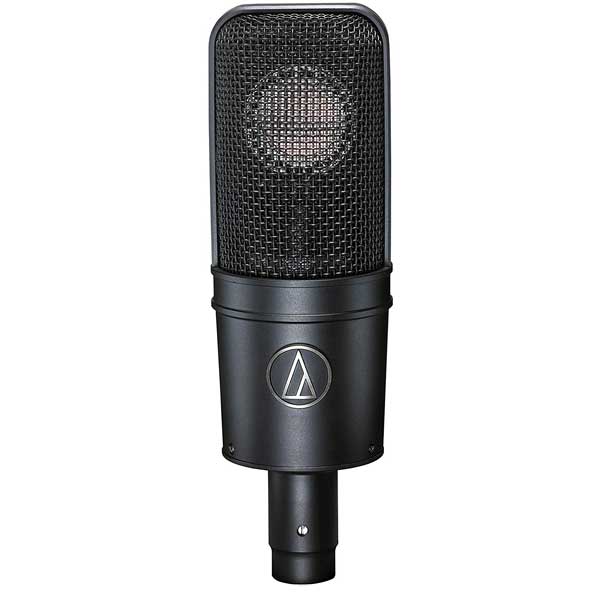
| Estimated Price | $300 |
| Type | Condenser |
| Diaphragm Size | Large |
| Polar Pattern | Cardioid |
| Frequency Response | 20Hz-20kHz |
| Max SPL | 145dB |
| Impedance | 100 Ohms |
My Review: This is the second Audio-Technica addition to our list, which goes to show that the company is one of the most reputable ones out there when it comes to mics. This time, we have one of the midrange models, called the AT4040. It is one of the most popular large-diaphragm condenser microphones on the market, and one which should definitely make the shortlist when you are choosing mics for recording acoustic guitars. It features a cardioid pattern, which rejects most of the noise coming from the sides and the back, and because the max SPL goes all the way up to 145dB, you get plenty of room to record loud guitar parts.
It comes with a shock mount and a dust cover, as well as a carrying case, which makes for a nice kit. Obviously, this is primarily a recording microphone and a great one at that. Acoustic guitars sound really accurate and natural, and you can even record your guitar amp without distortion. Even though its price puts it squarely in the middle of the range, this mic sounds a lot better than you would expect for the price, and the build quality and reliability are impressive, as well.
Who Will Use This Most: Because it’s so versatile, the AT4040 will appeal to a wide range of people, including hobbyists, recording artists, singer-songwriters, as well as producers, and engineers, who will find much to like in terms of sound and consistency.
Bottom Line: The Audio-Technica AT4040 offers crisp sound and clear highs, low noise, as well as the usual build quality and finish this brand is known for. You would be hard-pressed to find a better-sounding or more versatile acoustic guitar mic for the price.
16. Rode M5-MP Matched Pair Cardioid Condenser Microphones
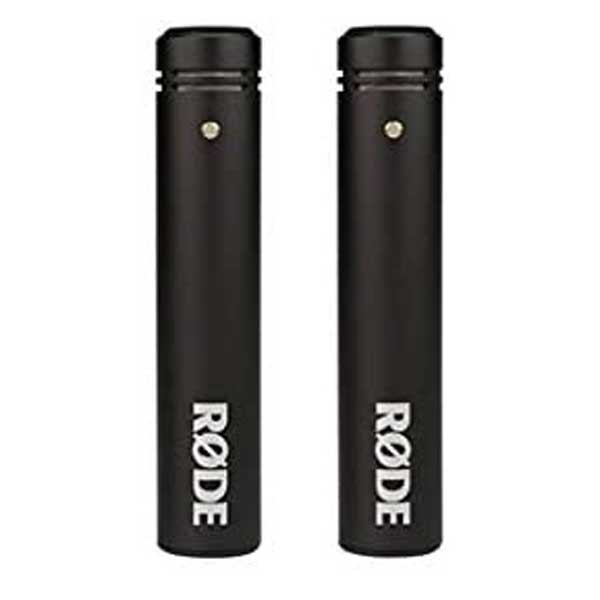
| Estimated Price | $195 |
| Type | Condenser |
| Diaphragm Size | Small |
| Polar Pattern | Cardioid |
| Frequency Response | 20Hz-20kHz |
| Max SPL | 140dB |
| Impedance | 200 Ohms |
My Review: This is by far one of the best mic deals you will find out there because you get a matched pair of Rode M5 mics for under $200. There are small-diaphragm condenser cardioid mics that are suitable for pretty much all occasions. Because of the tough metal body with a ceramic coating, which makes it more resistant to scratches, the Rode M5 works great in a live environment. In the studio, its narrow, pencil-style form makes it easy to set up and position, as it won’t get in the way, even when both mics are used for stereo recording.
When you buy a matched pair of these, you also get two RM5 stand mounts, as well as two WS5 windscreens, which are pretty much all the accessories you will need to get started. These mics will capture both the delicate single notes you are playing on your acoustic guitar, as well as loud chords and power chords, because of their high sensitivity and a high SPL of 140aB. Long story short, these are very versatile mics in terms of situation and music style.
Who Will Use This Most: Acoustic guitar players which are looking to take their sound to the next level with stereo recording, as well as studio professionals who need small-diaphragm condenser mics that won’t take up a lot of space and can handle loud noises.
Bottom Line: The Rode M5-MP matched pair of mics is one of the best ways to record your acoustic guitar in stereo without breaking the band. They work well in pretty much any setting, so if you don’t plan on investing a lot in mics, these will cover most of your recording needs just fine.
17. AKG Pro Audio C1000S
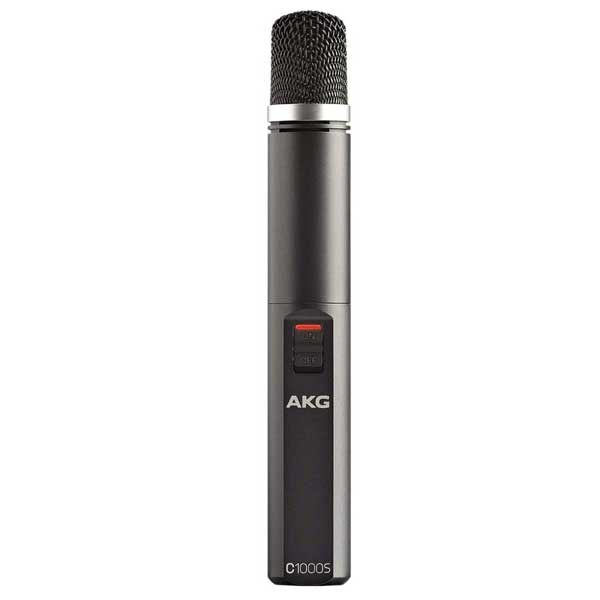
| Estimated Price | $170 |
| Type | Condenser |
| Diaphragm Size | Small |
| Polar Pattern | Multipattern |
| Frequency Response | 50Hz-20kHz |
| Max SPL | 137dB |
| Impedance | 200 Ohms |
My Review: Last, but not least, we have the AKG PRO Audio C1000S small-diaphragm condenser microphone, which complicates your choice a little, because it’s another great AKG, and there are plenty of those on our list. The C1000S is a bit different than other AKGs we have reviewed here because it features a switchable polar pattern. Specifically, you can choose between cardioid and hypercardioid, depending on the occasion. What’s also interesting about this mic is that you can power it either via phantom power or by using two AA batteries.
You can use this mic both on stage and in the studio, due to its sturdy build and a sound that feels a lot more expensive than the price tag indicated. The only slight issue we see with this mic is its size because it’s noticeably bigger than most other small-diaphragm condenser mics, which might make your job of positioning them in front of acoustic guitars a bit more difficult. It comes with a carrying case, windscreen, and stand adapter.
Who Will Use This Most: Given the fact that is moderately priced and versatile, it’s great for both hobbyists, musicians which play acoustic gigs often, as well as professionals who need mics for general recording use. Because of its XLR plug and gold capsule, it’s highly resistant to humidity, which makes it perfect for live performances.
Bottom Line: The AKG C1000S represents a great choice if you are looking for a versatile, multipattern mic for your acoustic guitar which will work well in any setting, and which won’t hurt your budget. You also get the standard AKG build quality included.
Choosing the Right Acoustic Guitar Mic (Buying Guide)
Technically, there are no mics that are designed specifically for acoustic guitars, which means you could use pretty much any microphone in a studio or a live setting. However, some mics lend themselves really well to particular situations and instruments, which is why we have gone through the trouble of explaining each major mic specification, along with suggestions on which type of microphone to use when with your acoustic guitar. With that in mind, take a look at the following when choosing a microphone for your acoustic guitar:
Dynamic vs Condenser Microphones
This is probably the first dilemma you will come across when shopping for mics for your acoustic guitar. Although there are other types, such as ribbon mics, the ones most commonly used with acoustic guitars are dynamic and condenser microphones. So, what’s the difference? Well, the most obvious difference would be in the way they are built. The way they capture sound and turn it into an electrical signal is rather different.
Condenser mics, which are also known as capacitor microphones, use a very light and thin diaphragm that is suspended by a fixed plate. The diaphragm moves as a result of sound wave pressure coming from the vocals or instruments. Dynamic mics, on the other hand, use a wire coil, which then amplifies the signal picked up by the diaphragm.
Dynamic microphones are more robust and sturdy, which makes them ideal for live performances, whereas condenser mics are ideal for studio recordings, or live settings such as concert halls. Dynamic mics are more suitable for when you need to capture large, loud sounds, such as those of drums, for example. They are also used for live guitar and vocals since they can take a beating, should you have a particularly active singer. If you are looking to capture those delicate, higher frequencies that you might get with an acoustic guitar, condenser mics are, nearly always, a better option.
Condenser microphones are more delicate in their construction, but that’s not the only reason why they are ideal for studio recordings. They are also more sensitive than their dynamic counterparts and therefore are better for capturing sounds such as vocals or acoustic guitars. This type of mics also requires external power or phantom power as it is called, to function, which means they need to be connected to an interface that can power them, be it a desk or a console. Although dynamic mics have their role in a studio, recording professionals mostly rely on condenser mics to record acoustic guitars. Condenser mics are also more expensive than dynamic mics.
Large vs Small Diaphragm Microphones
Both condenser and dynamic microphones are also categorized based on the size of their capsule, which is a part of the microphone responsible for turning sound into electrical signals. Based on the diameter of the capsule, microphones are usually separated into two categories: large- and small-diaphragm mics. The diameter of the diaphragm on large-diaphragm mics is anywhere between an inch and a half and two inches. Small-diaphragm condenser mics have a diaphragm about the size of a nickel. This is where things get tricky in the context of acoustic guitar because it’s difficult to pick one or the other since it all depends on what you are trying to achieve in terms of sound.
For example, large-diaphragm condenser microphones can capture not just the sound of the vocals or the instrument being played, but also the entire room or space you are recording or playing in, which can be a blessing or a curse. The reason why they are used for recording guitars is that they capture a fairly three-dimensional sound, especially in a room that has great acoustics. This allows them to be placed further away, which allows for sound to be captured not just from the soundboard of the guitar, but also its bridge, strings, as well guitar pick, which is something you would hear when an acoustic guitar is played without any amplification.
The drawback is that these mics do capture everything, including other sources that you may not necessarily want to mic or record, or if you are recording vocals and acoustic guitar at the same time. Simply put, large-diaphragm mics work great with acoustic guitars if you want a natural-sounding instrument, but you need to make sure that other sound sources don’t interfere in the process.
Small diaphragm condenser microphones, on the other hand, are perfect if you are looking to isolate certain sounds from the environment or capture the finest, most delicate sounds, which is why they are so common on movie sets where you have noise coming from the crew, cameras, and other equipment They are also known as pencil microphones because they are relatively long and narrow. When recording or micing an acoustic guitar, small-diaphragm mics are especially useful because you can sing and play guitar at the same time, without having to worry about the vocals spilling over on the guitar track.
If you are looking to vary the dynamics of your recording or emphasize the inherent treble tones of an acoustic guitar, small diaphragm condenser mics are a better option. Also, if you want to capture the most intricate sounds of the guitar, this type of mics is ideal, because it works extremely well for up-close recordings. This also completely eliminates the sounds coming from the room itself, if you are looking for that sort of isolation.
USB Microphones
USB microphones are relatively new on the market, and when it comes to their construction, they are pretty much identical to standard mics, apart from two additional components: a built-in preamp, and an A/D converter. The former enables you to simply plug the mic in and use it, without having to connect it to an external preamp or a mixer. The latter converts the analog output (in this case, voltage) into digital information so that it can be used by a computer, as well as sound-recording applications.
Although most sound purists would cringe at the idea of USB mics, they do have a few things going for them, such as convenience and portability. Sure, you don’t get the same sound quality as you get with standard mics, but if you are looking for something to carry around in your guitar case and mic or even record your guitar at any moment, USB microphones are a good solution, especially if you consider their plug-and-play compatibility. This means you can easily plug them into your tablet or phone, given the right adapter.
Polar Patterns Explained
Microphones are also categorized based on their capsule’s polar pickup pattern. Simply put, a polar pattern is a range at which a mic can capture sounds. The most common types of polar patterns are:
- Cardioid
- Omnidirectional
- Figure-8
- Multiple Pattern
- Wide Cardioid, Supercardioid, and Hypercardioid
Cardioid microphones are the most popular of them all, and they are also known as unidirectional mics since they can hear the sound produced directly in front of the mic, and cancel out the sound coming from the sides and the back. This polar pattern is somewhat heart-shaped, hence the term “cardioid”. As far as their application is concerned, they are not only ideal for situations involving multiple microphones, but also for when you need to limit the amount of feedback, background noise, or ambiance. As a result, you get a very dry sound. Cardioid mics are also tricky to use when they are close to the sound source, due to the proximity effect, which is exhibited as an increased bass response.
Omnidirectional microphones, just like their name indicates, can pick up sound coming from all directions. Whereas the polar pattern of cardioid mics is heart-shaped, the pattern of omnidirectional mics is a circle. The interesting thing about microphones is that they all start off as omnidirectional, after which they are engineered to get a specific polar pattern. The great thing about omnidirectional mics is that they are fairly immune to the proximity effect, which means you can get the mic really to the sound source. However, due to their pattern, they pick up everything, which can be great if you are going for capturing room and ambient sounds along with your guitar. They are more prone to feedback, as well.
Figure-8 microphones are sensitive to sounds coming from the front and the back, and they reject sounds coming from the side, which is why their polar pattern resembles a figure of eight. These microphones are also called bidirectional mics. Hearing sounds coming only from the front and the back is very hard to imagine for a human being, which is why Figure-8 mics are mostly used for advanced and very specific micing applications. This means they are also rarer.
Multiple pattern microphones enable you to choose between different polar patterns, which means they can also function as cardioid, omnidirectional, and Figure-8 mics. Also, it is not uncommon for them to feature additional polar patterns, as well as different intermediate settings,
Wide cardioid microphones, also known as subcardioids, are somewhere in between omnidirectional and cardioid mics in terms of sensitivity. For instance, unlike cardioids, they have higher rear sensitivity. In addition to that, their pattern allows them to pick up some of the sound coming from nearly all directions, but not with the same sensitivity as omnidirectional mics. This means you can capture not just the sound of your guitar, but room sounds as well, without having to worry about the proximity effect. However, they are very prone to feedback.
Supercardioid microphones have a tighter pickup than cardioids, which means they are even more selective about picking up the sounds coming from the front. However, they are also more sensitive to picking up sound sources from directly behind the mic. They are less sensitive to feedback, but one has to maintain a relatively stationary position in front of the mic to make use of this benefit.
Hypercardioid microphones share some of the traits with Figure-8 mics since they are sensitive to sounds coming from the rear. They are also very good at canceling out sounds coming from the sides, as well as feedback. However, because they are less sensitive at the front, they need to be placed very precisely in front of the sound source.
Purpose Specific Microphone Selection
This is the reason why it’s so difficult to name a specific mic, or even a specific mic category, as superior to others, simply because different applications require different mics. For example, if you want to mic your acoustic guitar for a live gig, then you are probably better off with a dynamic microphone since they can take the abuse that comes with a live performance. You would also be looking for omnidirectional mics because they can capture a very realistic, three-dimensional sound.
For studio recording, you would perhaps need a small-diaphragm cardioid mic that can reject room and ambient noise, yet capture all of the nuances of your guitar playing, and prevent the vocals from spilling over in case you are singing at the same time.
Microphone Terminology You Should Know
Frequency Response
You will often come across a frequency response that is defined as a range of frequencies that a particular microphone can hear and reproduce. Usually, the frequency response for most mics ranges between 20 Hz and 20,000 Hz, which isn’t saying much since that’s the exact range that a human ear can pick up. However, some microphones may cut off the top or the bottom of their frequency range, because they are used for specific purposes. For example, mics that are used to vocals usually cut off frequencies of 80hz and below to reduce rumble.
It would be a better idea to look at a graph of all frequencies for a specific mic since each one has a “sweet spot”, which are basically frequencies to which the mic responds the strongest.
Maximum SPL
Maximum SPL, or Sound Pressure Level, is a microphone’s response to extreme noise pressure. In most cases, you won’t need to worry about SPL since the maximum SPL is easily higher than the RMS value by over 20 dB for most music recording situations. In practical terms, you will mostly deal with SPL at which the THD (Total Harmonic Distortion) is between 0.5% and 1%, which is the point when you can hear the distortion of the sound. Maximum SPL happens when the THD value is 10%.
Output Impedance
When it comes to looking at the output impedance value for mics, keep in mind that it should be much lower than the input impedance of the preamp. In most cases, this value is about ten times lower than the input impedance. When it comes to condenser mics, their output impedance is the result of the total resistance of resistors that were used inside the microphone. This also means that the impedance doesn’t change with frequency. This is another aspect where dynamic and condenser mics differ. Dynamic microphones, which use a wire coil, are less constant in their impedance value as the frequency changes. This, in turn, can affect the mic’s frequency response.
Equivalent Noise Rating
Also sometimes listed as self-noise, ENR refers to the noise created by the electrical circuits inside the microphone. Of course, this means that the equivalent noise rating is a factor with condenser mics. It is usually listed as a dBA level. The lower the dbA level, the better, and most modern large diaphragm mics have a dBA level of just 5. Small diaphragm mics tend to be a little bit noisier, with a dBA level between 22 and 27. This is something you need to think about in terms of context since any kind of noise over 20 dBA will be a lot more apparent if the recording is taking place in a quieter environment.
Brand and Reliability
While the brand is definitely not the first thing you should look at when buying a mic for your acoustic guitar, it is still something you need to think about, because there are plenty of anonymous and questionable brands out there. Needless to say, the quality of their mic can be really hit or miss. On the other hand, they are cheaper. Reputable mic brands, such as Shure, AKG, SE, Neumann, and others are reputable because they have been putting out quality products for a long time. They are more expensive, but they justify the price tag with the excellent build quality, specs, and even design.
When it comes to reliability, most microphones nowadays are pretty sturdy and made out of metal. The only thing you really need to worry about if you are micing guitars is knocking your mic over. However, reliability can be an issue with low-quality brands since they save money by using cheap electronics which can break down more often, so keep that in mind.
Pairing with Accessories
You will find plenty of condenser mics nowadays which come with various accessories such as mic pouches, mic stands, shock mounts, pop filters, and so on. While all of these are useful, they are not always essential and will only hike up the price of the mic, which is something to consider if you are new to recording. Stick with the essentials first, and then buy all the different bells and whistles as you go along. But, regardless of how small your budget is, you should always spend your money on a high-quality cable.
If you are looking for a mic to use with your acoustic guitar inside the studio or live, then look no further than this article, which presents some of the best mics available, along with a ton of useful information and explanations you will need to figure out which specifications and features matter to you the most. Good luck!

My name is Chris and I’ve had a passion for music and guitars for as long as I can remember. I started this website with some of my friends who are musicians, music teachers, gear heads, and music enthusiasts so we could provide high-quality guitar and music-related content.
I’ve been playing guitar since I was 13 years old and am an avid collector. Amps, pedals, guitars, bass, drums, microphones, studio, and recording gear, I love it all.
I was born and raised in Western Pennsylvania. My background is in Electrical Engineering, earning a Bachelor’s degree from Youngstown State University. With my engineering experience, I’ve developed as a designer of guitar amplifiers and effects. A true passion of mine, I’ve designed, built, and repaired a wide range of guitar amps and electronics. Here at the Guitar Lobby, our aim is to share our passion for Music and gear with the rest of the music community.
